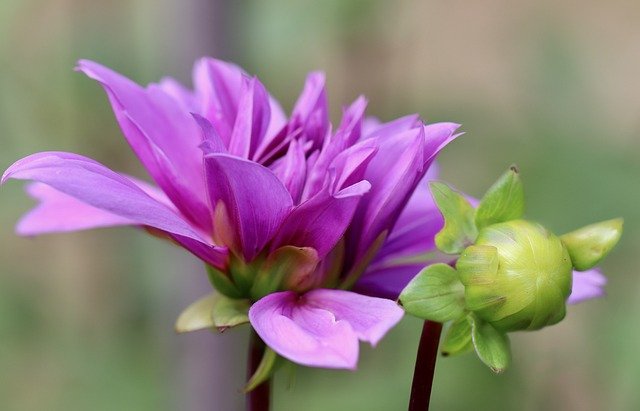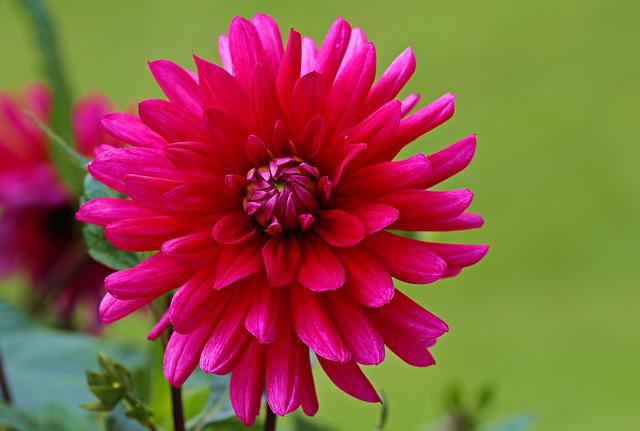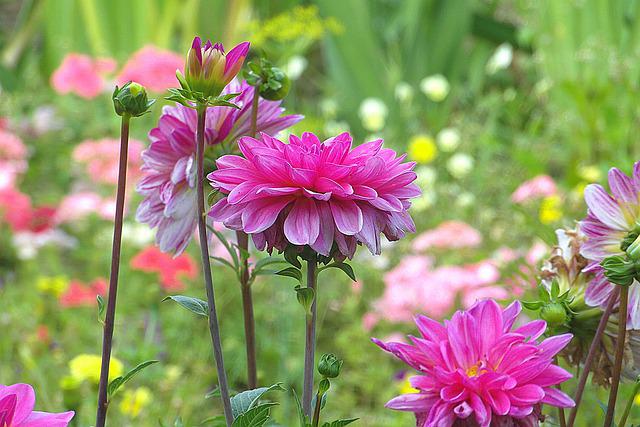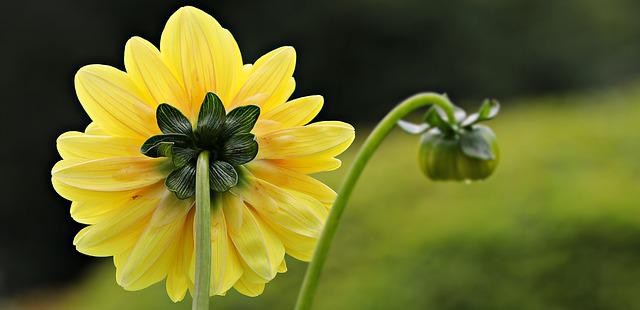When to Divide Dahlia Tubers? Increase Your Dahlia Tuber Supply By Dividing Dahlias

You can split up your dahlia tubers in the winter or the spring. You might want to wait until spring when the eyes of the tubers will be easier to see. Dahlia tubers should be divided when they reach a height of about 6-12 inches and are soft. This will help to increase yields and ensure optimal growth. The best time to do this is in the early morning or late evening, based on the moon phase. This will help to ensure that the plants get plenty of light and have enough time to reach their full potential.
Even if you reside in a growing location where dahlia tubers may survive the winter in the ground, you should still dig them up and split your tuber stock every few years. The mother tuber will ultimately deteriorate and produce fewer flowers. By dividing your tubers, you enable fresh growth each season and maintain a healthy tuber supply.
Table of Contents
Increase Your Dahlia Tuber Supply By Dividing Dahlias
Dahlia tuber excavation is a laborious operation. However, you will be rewarded with more viable tubers for next summer! Tubers of Dahlia are pricey. One of the most effective strategies to increase your supply is to split your tubers towards the conclusion of the growing season. One healthy plant may produce anything from three to twenty new tubers for the following season.
Get Ready To Pull Your Dahlia Tubers Out of the Ground
Most people prefer to postpone digging up their dahlia tubers until after their first killing frost. Your dahlia plants will be black in the morning, and your growing season will abruptly end. This is how you can tell if you’ve had a killing frost. You can dig up your dahlia tubers for storage after they have been in the ground and growing for at least 120 days.
Taking Out Your Dahlia Tubers From Under the Ground
Once you’ve either experienced your first killing frost or your dahlia tubers have been in the ground for at least 120 days, it is time to dig up your dahlias and store them for the winter. You will first want to prune your dahlia plants so that there are approximately 6 inches of stem left on the plant after you are finished. When you pull the plant out of the ground, you will find that grabbing it by the handle will be much simpler.
After the dahlia plants have all been pruned so that only six inches of stem are left, it is time to begin digging up the tubers planted in the ground. Put some gentle pressure on the pitchfork as you drive it into the ground with your pitchfork. Before picking up the cluster of dahlias, give the pitchfork a light rocking motion back and forth. After you have extracted the clump from the ground, carefully shake off any excess soil that may be attached to it. Keeping some of the soil around the tubers is important to better hold onto moisture.

How to Clean the Tubers of Your Dahlias
You will need to clean your dahlia tubers before you can divide them or put them away for the winter. Dress in clothes that are water resistant and that you are okay with getting wet in. In addition, I always make sure to have a pair of heavy-duty waterproof gloves. To clean the dahlias with a spray, you will need a hose and a good nozzle for the hose. It is important not to spray at too high of a setting, as this can cause the tubers to become broken or damaged.
Cutting the Stalks
Cutting a few days before digging makes it easier to divide clumps precisely because the eyes tend to come out. However, crown rot and destroyed tubers can result from water entering the stem. Furthermore, the virus could spread from one plant to the next if the same tool is used to cut all the stalks and the plants are left in the ground. Before moving from one plant to another, disinfect your cutting tools by dipping them in a solution of one bleach to ten parts water. If growers want to prevent water from seeping down into the crown after cutting the stalks early, they can use aluminum foil to seal the cut end of the stalk. If you want to be able to easily move and reposition the clumps, you should leave enough stem to do so.
Once the tops are removed, the clump can be sorted by variety. You must never separate the tag from its corresponding clump until you’ve finished labeling all of the tubers. Unlabeled tubers (of an unknown variety) are significantly less valuable than labeled ones. In addition to the name of the variety, be sure to highlight the top performers so that you can grow new plants from the healthiest and most robust specimens.
Carefully excavate and handle the clumps. Particularly soon after being unearthed, the neck of a dahlia tuber is extremely delicate. Dig around the plant’s perimeter, keeping your shovel a foot away from the central stalk, to unearth the clumps. Push the shovel or tined fork under the clump and lift carefully when all four sides are free from longer feeder roots. If there are any clumps of dirt, remove them carefully and turn them upside down so the stem can drain. The tubers are less likely to be damaged if dug in the morning and allowed to dry in the open for a few hours. After waiting a few hours, the tubers are less likely to break when the soil is removed.
When cleaning the clump, spray it with a garden hose to eliminate all the grime. The clump can be cut now.
There are costs and benefits to chopping up clumps. In contrast, it is much easier to find the eyes before they sprout in the fall, but some root varieties become so hard over the winter that a power saw is required to separate them in the spring. Fall is a popular time for root division, which is why many farmers do it then. Typically, gardeners have more free time in the fall than in the spring, and it is simpler to clean off and apply fungicide to divisions than it is to clumps. If a grower isn’t sure where to look for the eyes, he or she can always trim the stalks a few days before digging. You could also just cut it; some pieces will be eyeless.
Suppose the tubers of a particular variety are particularly fragile. In that case, if they have unusually thin necks and small crowns, or if they are unusually small and thin, novice growers may find it helpful to separate the clump into sections while leaving a few tubers together. Use masking tape that is 3/4 inches wide to keep the tubers from each section together.

Growing the plants in containers is another option for varieties with finicky roots. Care for a rooted cutting or tuber in a pot no larger than 4 inches, then plant the pot, so the top is just below the soil’s surface. The feeder roots will grow above the pot because there is an inch of soil above it. Even if the plant is cared for as though it were a potted dahlia rather than a show dahlia, the roots will form and remain healthier in a more confined environment.
The fact that growers typically choose poor root makers varieties to cultivate in pots means that the roots produced by plants grown in pots are typically smaller than those produced by plants grown in the open. To harvest tubers from pots, you must first remove the top inch or two of the stalk before digging up the pot. Remove the roots that look like hair if they grow from the planters. Thick tubers that grow beyond the container can be trimmed down. Taking pot roots out of their container is one treatment option. The clump can be dried for a day or two, washed, and then stored in a bag with vermiculite. Or, you could just leave the pot roots where they are, attach the name tag, and wrap the whole thing in six sheets of newspaper. The pots should be stored in brown paper bags alongside other tubers. Bring the container indoors and begin watering come spring. Once the eyes have developed shoots, you can take cuttings or divide the roots, repot each section, and grow them on as new plants.
Dividing the Clumps
When dividing clumps, include an eye-shaped crown piece in each section. Any remaining stem will encourage crown rot, which will ruin the tuber, so be sure to eliminate it. After separating each clump, it is essential to thoroughly clean the cutting tools. The most economical method of disinfecting knives and hands from the dahlia virus is to use a bleach solution of 1 part bleach to 10 parts water. Veteran farmers advocated for using fire to sterilize cutting tools a few decades ago, advising farmers to heat the blades over an open flame until they were red hot and then cool them before reusing them. Rather than waiting for each knife to cool down after being sterilized, you can save time by using a set of carpet knives with a hook design and rotating them.
Inspect the sections thoroughly as you cut through the clumps. The “mother root” is usually thrown away. There is a correlation between the number of feeder roots and the distance they are from the mother root. Reduced plant and tuber quality is the result of inadequate feeder roots. Some notable growers have been known to save the mother root, propagate from it with cuttings, and then discard the original plant.
The only size requirement for tubers is that they survive the winter without drying out. Indeed, some seasoned growers favor small roots over large ones unless they use them exclusively for cuttings. It appears that large tubers of some varieties inhibit the development of feeder roots. Smaller tubers, rather than larger ones, will yield healthier plants and more beautiful blooms for these varieties. However, fully mature smaller tubers are preferred. Smaller, more immature roots originating from laterals that develop later in the plant’s life cycle are more susceptible to rotting than their larger, more fully developed counterparts. One solution is to rely on older, larger roots but prune them down to a manageable size, discarding the rest. Don’t throw away any of the tubers until you’ve clearly labeled the variety it comes from. Start a few tubers per clump in a 4-inch pot in the spring, let them grow for a few weeks, and then transplant the strongest plants outdoors for the best results.

The clumps must have all feeder roots, and stalks cut off (both promote rot). Remove any rusty or brown spots from the interior of the crown. The tuber will likely rot due to crown rot, which is indicated by the discoloration. If any dirt was missed when washing the clump, you could get it off the tubers by cutting them into smaller pieces and then giving them another good washing with a hose or inside a laundry tub.
Remove the dirt and then trim the tuber’s end. Deterioration can be seen if a brown or rusty section is in the middle or halfway out. If any of these conditions apply, a section of the tuber should be cut away in the direction of the crown to determine if the crown can be seen. If this is the case, the tuber should be fine. If it doesn’t work, toss it.
There are insect holes in the middle of some tubers, not far from the top. It is a problem if a rotting-promoting organism can fit through an insect hole. To avoid eating insect holes, slice above them and look for a spot on the tuber that isn’t brown or rusty.
